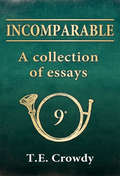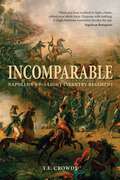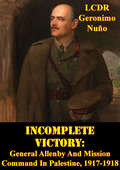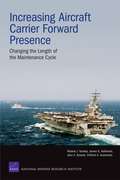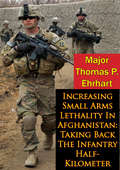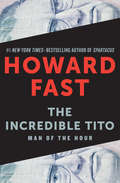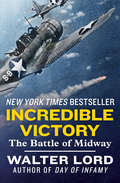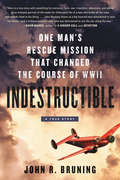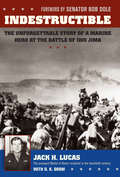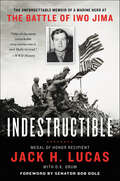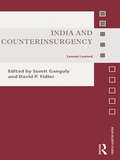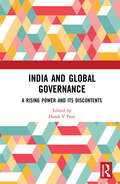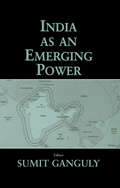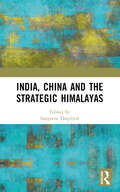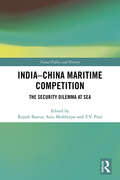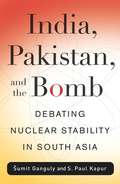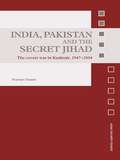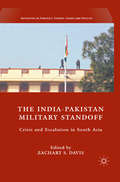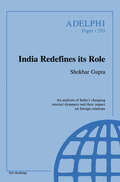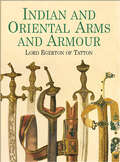- Table View
- List View
Incomparable: a collection of essays
by Terry CrowdyAn elite battalion under Louis XVI, the 9th Light Infantry regiment were with Napoleon from almost the beginning of his campaigns, so much so that he dubbed them 'Incomparable'. This collection of essays studies their early history and formation, prior to being so vital during the Napoleonic Wars.
Incomparable
by Terry CrowdyFrance's 9th Light Infantry regiment was created as an elite battalion in Louis XVI's Royal Army. After the aristocratic officers fled from the Revolution, command of the battalion fell to a close-knit group of grizzly ex-NCOs, idealistic revolutionaries and a young, battle-scarred captain, Mathieu Labassée. In 1799, as First Consul of the Republic, Napoleon needed a military victory to cement his political power. He drove a hastily gathered army across the Swiss Alps to recapture northern Italy from the Austrians. It was a risky gamble which very nearly failed. At Marengo Napoleon is taken by surprise. His army were in open retreat when the Ninth arrived late on the field. As Napoleon's last hope they were launched forward to stop the Austrians and give the rest of the army time to recover. Their charge was so ferocious it breaks Austrian morale and precipitates their headlong flight from the battlefield.With the crown of France within his reach, Napoleon was generous in his praise for the Ninth, dubbing them 'Incomparable'. They were feted as celebrities in Paris, but success went to their heads, some officers turned to drink, others fought duels against rivals in Napoleon's Guard. A new commander, Claude Meunier was brought in to bring about change: The Ninth's prestige was now at its peak.From such heady heights, the fear of failure became a powerful motivator. Through successive campaigns in Austria, Prussia, Poland and Spain, the regiment proved its worth. Eventually the strain began to show. The misery of guerrilla war sucks the life and soul out of the regiment. By the time the Allies reached Paris in 1814, the regiment could muster only a handful of men capable of holding their place in the line. They fight on, regardless. In 1815 Napoleon returns from exile in Elba. The Ninth immediately acclaim his return and take their cherished Eagle out of hiding, promising once again to conquer or die. The climax of the book comes ten miles from Waterloo on a bridge over the River Dyle. The Ninth spearheaded the charge to rejoin Napoleon. Like Marengo, their late arrival might save the day. Unlike Marengo, they fail. Even in defeat their story is extraordinary - even by the standards of the dramatic and turbulent years in which they lived.This is not a traditional regimental history. It is the story of people who were caught up in the blazing trail of Napoleon's epic career. It describes the Napoleonic war machine from within, shedding light on the lives and feats of soldiers on whose toil a spectacular Empire was built and lost.
Incomplete Victory: General Allenby And Mission Command In Palestine, 1917-1918
by Lcdr Geronimo NuñoThe Palestine Campaign of the First World War exhibited a fighting style that brought with it various challenges in mission command. While General Allenby, commanding the Allied Egyptian Expeditionary Force (EEF), gained several victories in the early stages of the campaign, he did not comprehensively defeat the Turkish forces in Palestine. He drove them away from their defensive line, but they escaped, avoided destruction, and retreated north to re-establish a defense and engage the EEF at later date. This thesis argues that General Allenby did not achieve the great successes at the battles of Beersheba, Gaza, Sheria, and the pursuit of Turkish forces that ended with Allenby's capture of Jerusalem. Instead, Allenby had to learn how to succeed in Palestine to finally destroy the armies of the Ottoman Empire in Palestine at the battle of Megiddo in September 1918. The research in this study highlights the mission command challenges in Allenby's early campaigns and how he learned to overcome them and adapt his tactics to achieve complete victory at the battle of Megiddo. This thesis will use the tenets of mission command, consisting preparation, combined arms, prioritization of resources, and communication, to examine General Allenby's Palestine campaign. Mission command, both a function of war and a philosophy of leadership comprises one of the key facets of military thought that leaders must consider in order to achieve complete victory.
Increasing Aircraft Carrier Forward Presence: Changing the Length of the Maintenance Cycle
by Roland J. Yardley John F. Schank James G. Kallimani Clifford A. GrammichThe U.S. Navy's aircraft carrier fleet must meet the forward presence requirements of theater commanders. With a decreasing fleet size, planners must balance the timing of maintenance, training, and deployment with presence and surge demands. Evaluating multiple one- and two-deployment scenarios per cycle, RAND examines the feasibility of different cycle lengths, their effect on carrier forward presence, and their impact on shipyard workloads.
Increasing Small Arms Lethality In Afghanistan: Taking Back The Infantry Half-Kilometer
by Major Thomas P. EhrhartOperations in Afghanistan frequently require United States ground forces to engage and destroy the enemy at ranges beyond 300 meters. These operations occur in rugged terrain and in situations where traditional supporting fires are limited due to range or risk of collateral damage. With these limitations, the infantry in Afghanistan require a precise, lethal fire capability that exists only in a properly trained and equipped infantryman. While the infantryman is ideally suited for combat in Afghanistan, his current weapons, doctrine, and marksmanship training do not provide a precise, lethal fire capability to 500 meters and are therefore inappropriate.Comments from returning non-commissioned officers and officers reveal that about fifty percent of engagements occur past 300 meters. The enemy tactics are to engage United States forces from high ground with medium and heavy weapons, often including mortars, knowing that we are restricted by our equipment limitations and the inability of our overburdened soldiers to maneuver at elevations exceeding 6000 feet. Current equipment, training, and doctrine are optimized for engagements under 300 meters and on level terrainThere are several ways to extend the lethality of the infantry. A more effective 5.56-mm bullet can be designed which provides enhanced terminal performance out to 500 meters. A better option to increase incapacitation is to adopt a larger caliber cartridge, which will function using components of the M16/M4. The 2006 study by the Joint Service Wound Ballistics-Integrated Product Team discovered that the ideal caliber seems to be between 6.5 and 7-mm. This was also the general conclusion of all military ballistics studies since the end of World War I.
Incredible Seney
by Lewis C. ReimannThe first complete story of Michigan’s fabulous lumber town, this is the third book in a series dealing with the pioneer life in the Upper Peninsula of Michigan. First published in 1953 it was written by Upper Peninsula native, Lewis C. Reimann, “with the assistance of many witnesses of the early scenes of that rugged period—old time lumberjacks, woods bosses, descendants of the pioneer families and many others interested in those hardy people.”It is richly illustrated throughout with black & white photographs.
The Incredible Tito: Man of the Hour
by Howard FastFast&’s fascinating biography of Joseph Broz, known to the world as Tito, including his rise to power and his remarkable stand against fascismThe world was mired in the Second World War when Howard Fast wrote The Incredible Tito. Upon the book&’s publication in 1944, there was still no united Yugoslavia, the Axis controlled most of Europe, and D-Day was only in the planning stages. In the Balkans, Tito was a beacon of hope against the advancing Nazis. He led a force of resistance fighters that bedeviled the occupying German army throughout Slavic regions and empowered people&’s committees to act as local government in all liberated areas. For observers on the political left, Tito seemed uniquely poised to unite the East and West against fascism—once and for all. This ebook features an illustrated biography of Howard Fast including rare photos from the author&’s estate.
Incredible Victory: The Battle of Midway (Classics Of War Ser.)
by Walter LordThe &“remarkable&” New York Times bestseller about the battle in the Pacific that turned the tide of World War II—from the author of The Miracle of Dunkirk (Los Angeles Times). On the morning of June 4, 1942, doom sailed on Midway. Hoping to put itself within striking distance of Hawaii and California, the Japanese navy planned an ambush that would obliterate the remnants of the American Pacific fleet. On paper, the Americans had no chance of winning. They had fewer ships, slower fighters, and almost no battle experience. But because their codebreakers knew what was coming, the American navy was able to prepare an ambush of its own. Over two days of savage battle, American sailors and pilots broke the spine of the Japanese war machine. The United States prevailed against momentous odds; never again did Japan advance. In stunning detail, Walter Lord, the #1 New York Times–bestselling author of Day of Infamy and A Night to Remember, tells the story of one of the greatest upsets in naval history. &“Graphic and realistic . . . not an impersonalized account of moves on the chessboard of war, [but] a story of individual people facing crucial problems.&” —The New York Times
Incredible Victory: The Battle of Midway
by Walter LordThe &“remarkable&” New York Times bestseller about the battle in the Pacific that turned the tide of World War II—from the author of The Miracle of Dunkirk (Los Angeles Times). On the morning of June 4, 1942, doom sailed on Midway. Hoping to put itself within striking distance of Hawaii and California, the Japanese navy planned an ambush that would obliterate the remnants of the American Pacific fleet. On paper, the Americans had no chance of winning. They had fewer ships, slower fighters, and almost no battle experience. But because their codebreakers knew what was coming, the American navy was able to prepare an ambush of its own. Over two days of savage battle, American sailors and pilots broke the spine of the Japanese war machine. The United States prevailed against momentous odds; never again did Japan advance. In stunning detail, Walter Lord, the #1 New York Times–bestselling author of Day of Infamy and A Night to Remember, tells the story of one of the greatest upsets in naval history. &“Graphic and realistic . . . not an impersonalized account of moves on the chessboard of war, [but] a story of individual people facing crucial problems.&” —The New York Times
The Increment
by David IgnatiusFrom a hidden enclave in the maze of Tehran, an Iranian scientist who calls himself "Dr. Ali" sends an encrypted message to the CIA. It falls to Harry Pappas to decide if it's for real. Dr. Ali sends more secrets of the Iranian bomb program to the agency, then panics. He's being followed, but he doesn't know who's onto him, and neither does Pappas. The White House is no help -- they're looking for a pretext to attack Tehran. To get his agent out, Pappas turns to a secret British spy team known as "The Increment," whose operatives carry the modern version of the double-0 "license to kill." But the real story here is infinitely more complicated than he understands, and to get to the bottom of it, he must betray his own country. The Increment is The Spy Who Came In from the Cold set in Iran, with a dose of Graham Greene's The Human Factor to highlight the subtleties of betrayal.
An Indecent Obsession
by Colleen McCulloughTo the battle-broken soldiers in her care, nurse Honour Langtry is a precious, adored reminder of the world before war. Then Michael Wilson arrives under a cloud of mystery and shame to change everything.
Indestructible: One Man's Rescue Mission That Changed the Course of WWII
by John R BruningIn this remarkable WWII story by New York Times bestselling author John R. Bruning, a renegade American pilot fights against all odds to rescue his family--imprisoned by the Japanese--and revolutionizes modern warfare along the way.From the knife fights and smuggling runs of his youth to his fiery days as a pioneering naval aviator, Paul Irving "Pappy" Gunn played by his own set of rules and always survived on his wits and fists. But when he fell for a conservative Southern belle, her love transformed him from a wild and reckless airman to a cunning entrepreneur whose homespun engineering brilliance helped launch one of the first airlines in Asia.Pappy was drafted into MacArthur's air force when war came to the Philippines; and while he carried out a top-secret mission to Australia, the Japanese seized his family. Separated from his beloved wife, Polly, and their four children, Pappy reverted to his lawless ways. He carried out rescue missions with an almost suicidal desperation. Even after he was shot down twice and forced to withdraw to Australia, he waged a one-man war against his many enemies--including the American high command and the Japanese--and fought to return to the Philippines to find his family.Without adequate planes, supplies, or tactics, the U.S. Army Air Force suffered crushing defeats by the Japanese in the Pacific. Over the course of his three-year quest to find his family, Pappy became the renegade who changed all that. With a brace of pistols and small band of loyal fol,lowers, he robbed supply dumps, stole aircraft, invented new weapons, and modified bombers to hit harder, fly farther, and deliver more destruction than anything yet seen in the air. When Pappy's modified planes were finally unleashed during the Battle of the Bismarck Sea, the United States scored one of the most decisive victories of World War II. Taking readers from the blistering skies of the Pacific to the jungles of New Guinea and the Philippines to one of the the war's most notorious prison camps, Indestructible traces one man's bare-knuckle journey to free the people he loved and the aerial revolution he sparked that continues to resonate across America's modern battlefields.
Indestructible: The Unforgettable Story of a Marine Hero at Iwo Jima
by Jack Lucas D. K. DrumDuring the battle of Iwo Jima, two enemy grenades landed close to Jack Lucas and his buddies. Jack threw himself on one of the grenades, grabbed the second, and pulled it beneath his body. His buddies were saved, but Lucas was badly injured. Miraculously, he survived-but just barely. For this brave action seventeen-year-old Jack Lucas from North Carolina became the youngest Marine in history to receive the Medal of Honor. Indestructible reveals the rocky road that led Jack Lucas to Iwo Jima, his arduous recovery, and the obstacles Jack overcame later in life. Jack’s moving and powerful memoir is a testament to America’s greatest generation.
Indestructible: The Unforgettable Memoir of a Marine Hero at the Battle of Iwo Jima
by Jack H. Lucas D. K. DrumMedal of Honor recipient Jack H. Lucas’s classic memoir of his heroics at the Battle of Iwo Jima—with a foreword by Bob Dole and reissued to coincide with the 75th anniversary of the battle in 2020.On February 20, 1945, the second day of the assault on Iwo Jima—one of the bloodiest battles of the Pacific theater in World War II—Private Jack Lucas, who was only seventeen, and three other Marines engaged in a close-proximity firefight with Japanese soldiers. When two enemy grenades landed in their trench, Lucas jumped on one and pulled the other under his body to save the lives of his comrades. Lucas was blown into the air as his body was torn apart by 250 entrance wounds. He was so severely wounded that his team left him for dead. Miraculously, he survived.While on the hospital ship Samaritan, his spirit soared to see the American flag flying atop Mount Suribachi—the same flag immortalized in Joe Rosenthal’s iconic photograph, Raising the Flag on Iwo Jima. Lucas endured twenty-one grueling surgeries and carried 200 pieces of shrapnel in his body for the rest of his life. Awarded the Medal of Honor, he became the youngest Marine in U.S. history—and the youngest of all World War II servicemen—to receive the honor.Indestructible tells the remarkable story of an extraordinary American possessed with a fierce determination to serve his country.
India and Counterinsurgency: Lessons Learned (Asian Security Studies)
by Sumit Ganguly David P. FidlerThis edited volume focuses on India's experiences waging counterinsurgency campaigns since its independence in 1947. Filling a clear gap in the literature, the book traces and assess the origins, evolution and current state of India's counterinsurgency strategies and capabilities, focusing on key counterinsurgency campaigns waged by India within and outside its territory. It also analyzes the development of Indian doctrine on counterinsurgency, and locates this within the overall ebb and flow of India's defense and security policies. The central argument is that counterinsurgency has been an integral part of India's overall security policy and can thereby impart much to political and military leaders in other states. Since its emergence from British colonialism, India's defence policies have not merely sought to protect and preserve India's inherited colonial borders from threats by rival states, but have also sought to prevent and suppress secessionist movements. In countering insurgencies, the Indian state has fashioned strategies that seek to repress militarily any secessionist movement, while simultaneously forging a range of civilian administrative and institutional arrangements that attempt to address the grievances of disaffected populations. The book highlights key strategic and tactical innovations that the Indian Army and security forces made to deal with a range of insurgent movements. Simultaneously, it also examines how the civilian-military nexus enabled India's policy makers to utilize existing, and formulate novel, institutional means to address extant political grievances. India has been most successful where it has managed to use calibrated force, obtained the trust of much of the aggrieved population and made persuasive commitments to political and institutional reform. Examination of these elements of India's counterinsurgency performance can be compared to counterinsurgency doctrine developed by other countries, including the United States, and thus yield comparative policy prescriptions and recommendations that can be applied to other counterinsurgency contexts. This book will be of great interest to students of counterinsurgency and irregular warfare, Indian politics, Asian Security Studies and Strategic Studies in general.
India and Global Governance: A Rising Power and Its Discontents
by Harsh V PantThis volume explores India’s role in the global governance architecture post–Cold War. It shows how, with a rise in India’s capabilities, there is an expectation from its external interlocutors that New Delhi ought to play a larger global role. As Indian policymakers redefine their engagements in the global policy matrix, the chapters in the volume analyse India’s role as a challenger and a stakeholder in world politics; its uneasy relationship with Western liberal democracies; and its role in shaping new structures of global governance. The volume focuses on a host of critical issues, including nuclear policy, climate action politics, India’s bid for a permanent seat at the UN Security Council, humanitarian interventions, trade governance, democracy promotion, India’s engagement with other emerging powers in platforms such as the BRICS, the changing dynamics with its neighbours, and maritime governance. A timely reimagining of global politics, this book will be of great interest to scholars and researchers of politics and international relations, climate change, military and strategic studies, economics, and South Asian studies.
India as an Emerging Power
by Sumit GangulyThese essays examine India's relations with key powers including the Russian Federation, China and the USA and with key adversaries in the global arena in the aftermath of the Cold War. One positive relationship is that of India's relations with Israel since 1992.
India, China and the Strategic Himalayas
by Sangeeta ThapliyalThis book analyses strategic discourse on the Himalayas from the perspective of India’s interests. Home to many communities, cultures, natural resources and political boundaries, it is the geopolitical landscape of the Himalayas between India and China that dominates other narratives and discourses. The traditional notion of Himalayas as India’s frontiers and buffer is challenged by China. Despite various mechanisms to address border resolution there are violations and transgressions from China. This book examines India’s responses to the new emerging challenges in the Himalayas. How the statist discourse on strategic interests incorporates people’s discourse. It provides a nuanced understanding of India’s strategic undertakings, diplomatic initiatives and development framework. This book will be a valuable addition to existing knowledge on the Himalayas between India and China. Scholars and practitioners interested in International Relations, Strategic Studies, Himalayan Studies and South Asian Studies will find it useful. Print edition not for sale in South Asia (India, Sri Lanka, Nepal, Bangladesh, Pakistan and Bhutan)
India-China Maritime Competition: The Security Dilemma at Sea (Cass Series: Naval Policy and History)
by Rajesh Basrur Anit Mukherjee T. V. PaulThis edited volume critically examines the concept of the “security dilemma” and applies it to India–China maritime competition. Though frequently employed in academic discussion and popular commentary on the Sino-Indian relationship, the term has rarely been critically analysed. The volume addresses the gap by examining whether the security dilemma is a useful concept in explaining the naval and foreign policy strategies of India and China. China’s Belt and Road Initiative and its expansive engagement in the Indian Ocean Region have resulted in India significantly scaling up investment in its navy, adding ships, naval aircraft and submarines. This volume investigates how the rivalry is playing out in different sub-regions of the Indian Ocean, and the responses of other powers, notably the United States and prominent Southeast Asian states. Their reactions to the Sino-Indian rivalry are an underexplored topic and the chapters in this book reveal how they selectively use that rivalry while trying to steer clear of making definite choices. The book concludes with recommendations on mitigating the security dilemma. This work will be of great interest to students of strategic studies, international relations, maritime security, and Asian politics.
India, Pakistan, and the Bomb: Debating Nuclear Stability in South Asia
by Ganguly Umit S. Paul KapurIn May 1998, India and Pakistan put to rest years of speculation as to whether they possessed nuclear technology and openly tested their weapons. Some believed nuclearization would stabilize South Asia; others prophesized disaster. Authors of two of the most comprehensive books on South Asia's new nuclear era, Sumit Ganguly and S. Paul Kapur, offer competing theories on the transformation of the region and what these patterns mean for the world's next proliferators. Ganguly begins with an outcome-based approach emphasizing the results of militarized conflict. In his opinion, nuclear weapons have prevented Indo-Pakistani disputes from blossoming into full-scale war. Kapur counters with a process-based approach stressing the specific pathways that lead to conflict and escalation. From his perspective, nuclear weapons have fueled a violent cycle of Pakistani provocation and Indian response, giving rise to a number of crises that might easily have spun into chaos. Kapur thus believes nuclear weapons have been a destabilizing force in South Asia and could similarly affect other parts of the world. With these two major interpretations, Ganguly and Kapur tackle all sides of an urgent issue that has profound regional and global consequences. Sure to spark discussion and debate, India, Pakistan, and the Bomb thoroughly maps the potential impact of nuclear proliferation.
India, Pakistan and the Secret Jihad: The Covert War in Kashmir, 1947-2004 (Asian Security Studies)
by Praveen SwamiIndia, Pakistan and the Secret Jihad explores the history of jihadist violence in Kashmir, and argues that the violent conflict which exploded after 1990 was not a historical discontinuity, but, rather, an escalation of what was by then a five-decade old secret war. Praveen Swami addresses three key issues: the history of jihadist violence in Jammu and Kashmir, which is examined as it evolved from 1947-48 onwards the impact of the secret jihad on Indian policy-making on Jammu and Kashmir, and its influence on political life within the state why the jihad in Jammu and Kashmir acquired such intensity in 1990. This new work will be of much interest to students of the India-Pakistan conflict, South Asian politics and security studies in general.
The India-Pakistan Military Standoff
by Zachary S. DavisThis book focuses on the 2001-2002 crisis that brought India and Pakistan to the brink of war. Authors focus on: the political history that led to the crisis; the conventional military environment, the nuclear environment and coercive diplomacy and de-escalation during the crisis; and how South Asia can avoid similar crises in the future.
India Redefines its Role (Adelphi series #293)
by Shekhar GuptaFirst Published in 2005. Routledge is an imprint of Taylor & Francis, an informa company.
Indian and Oriental Arms and Armour (Dover Military History, Weapons, Armor)
by Lord Egerton of TattonOriginally created in the late 19th century to catalog Indian and Oriental arms and armor for a British museum, this volume has long since become a sourcebook of vital information on the military history of India. Enhanced with excellent illustrations, it remains one of the few books available on the subject, providing factual accounts of events ranging from the earliest invasions of the subcontinent in 200 B.C. to the decline of the Mogul Empire (early 18th century) and the First Burmese War in 1824. In addition to information on military history, succeeding chapters describe Indian swords, helmets, knives, shields, daggers, spears, javelins, blowpipes, sabers, and a host of other weapons, including arms used for athletic and sacrificial purposes. Descriptive notes, grouped according to geographical areas, comment on styles of decoration, manufacturing processes, and ethnological characteristics. A shorter section of the book includes detailed information on Arab and Persian arms (maces, battle axes, matchlock guns, bows and arrows, etc.) and Japanese armor. Students of Far Eastern arms and armor as well as enthusiasts of military history will welcome this comprehensive reference. 350 halftones and line illustrations. 350 halftones and line illustrations.
The Indian Army and the End of the Raj
by Daniel MarstonThe Partition of British India in 1947 resulted in the establishment of the independent states of India and Pakistan and the end of the British Raj. The decision to divide British India along religious lines led to widespread upheaval and communal violence in the period leading up to and following the official day of independence, 15 August 1947. In this book, Daniel Marston provides a unique examination of the role of the Indian army in post-World War II India. He draws upon extensive research into primary source documents and interviews with veterans of the events of 1947 to provide fresh insight into the vital part that the Indian Army played in preserving law and order in the region. This rigorous book fills a significant gap in the historiography of the British in India and will be invaluable to those studying the British Empire and South Asia more generally.
